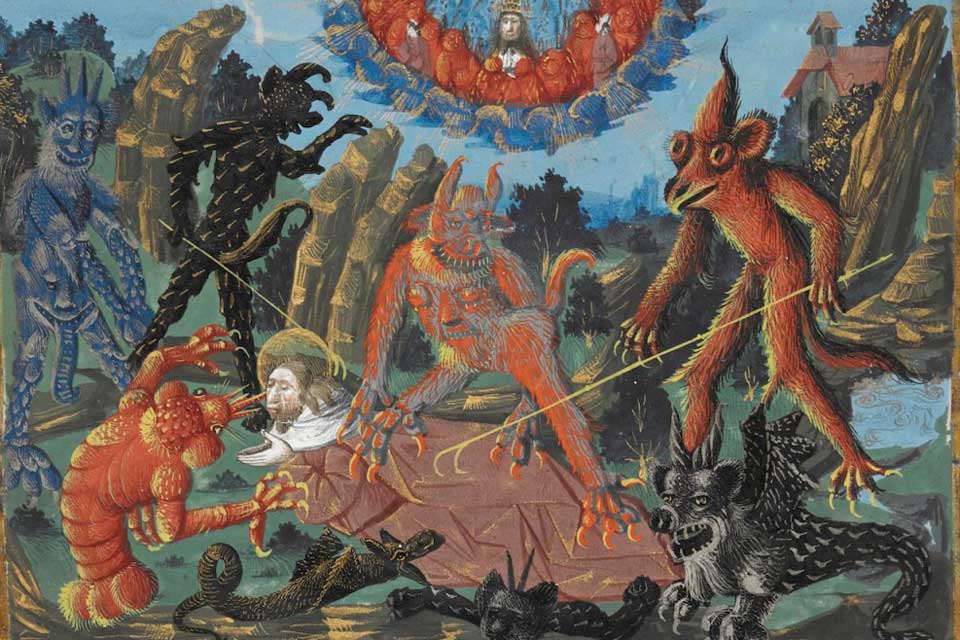Recurring nightmares seems to be one of the unforeseen complications following Covid-19. Some people report being attacked by masked medieval monsters.
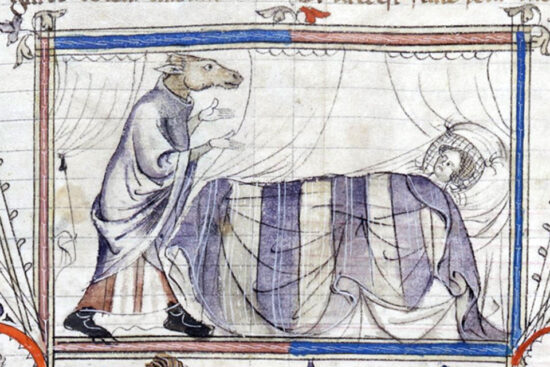
In May 2020, more than 3000 US adults were interviewed online about their dreams and the COVID-19 pandemic. Of these, more than a third reported to have experienced a heightened level of anxiety, depression, and stress, and 29% reported an increase in dream recall, with a significant rise in negative dream emotions. Of these, the major topics of dreams were social distancing and masking. Further, the study showed that people affected personally – either through their personal illness or that of a beloved next of kin – were especially prone to nightmares (PTSD). Typically, the dreams centred upon being confined (behind masks), or stigmatised for not living up to masking’s social standards. In a parallel, although small study, a group of Canadian students were found to have had a statistically significant number of dreams focusing on heads, animals, food, as well as shifts in location. In a further study carried out in Finland, where 4275 citizens participated, 56% were reported as experiencing increased stress levels, while 20% reported their dream content was focusing on the virus, death, work, friends or crowds. More specifically the Finnish scientists found that 55 % of the “bad” dreams contained pandemic-specific content such as failures in social distancing, covid-19 contagion, issues with personal protective equipment, and dystopian and apocalyptic pandemic-related scenarios. Elsewhere people have even reported being attacked by “masks” or “masked animal monsters.
The question, though, is what these masked monsters represent? What do they reveal? Fundamental Angst? Social shame? Or? Since masking has a long and fascinating cultural history revealing the essence of different ideas of the good society, a short presentation of the cultural history of masking may provide some answers. Although masking is ubiquitous in most human societies, I shall limit the discussion to a traditional Western European context.
The Prósōpon and the Person
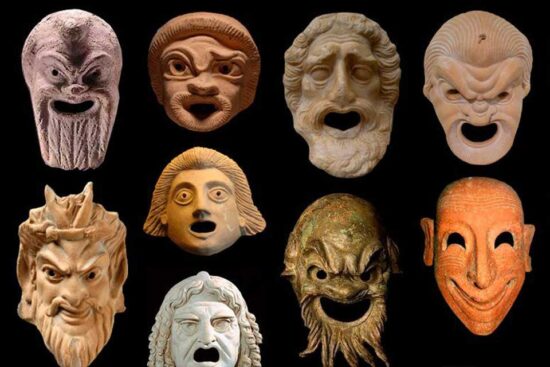
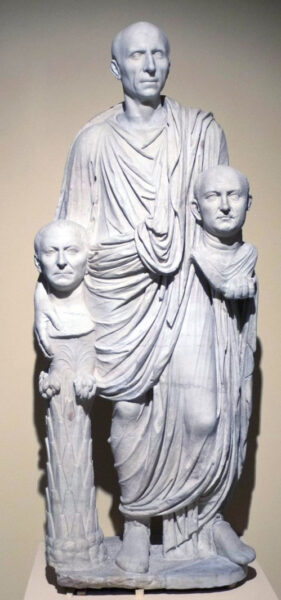
In ancient Greek tragedies, the members of the chorus would wear a πρόσωπον – prósōpon – that is a face or a mask. Such masks were made of leather, painted canvas or ceramics, and would be used to introduce certain universal characters – faces – on to the scene. When an actor donned such a prósōpon, he would take upon himself a particular “face”, intended to reveal his role in the play, which initially was a religious ritual, enabling the actors to stand outside themselves, become ecstatic, enter ekstasis, the realm of Dionysus; and thus reveal themselves and their inner nature.
Such was the impact of Hellenistic culture that the New Testament books came to be considered in their literary form as reflecting the Greek Tragedies, with the word “prósōpon” or “persona” as one of the preferred designations of the divine “persons” of the trinity. In this context, the “mask” was employed as a theatrical ploy intended to offer an understanding of the revealed (ecstatic) character of veiled God – revealed as the Father, the Son and the Holy Ghost as three “prósōpona”. We meet this literary scheme in Matthew 17:2 where Jesus on the mountain transfigures himself in front of Peter, Jacob and John while letting his face – his prosōpon – shine like the sun. Whether Dionysian or Christian, both movements led to the same “mode of being”, social dissolution.
The Latin equivalent of the prósōpon was the persona – person. However, this Latin term’s meaning was not quite identical to that of the Greek prósōpon.
Rather than employing masks as theatrical props, the Romans began to reinvent the Greek “masks” by using wax to create their ancestors’ death-masks. Such personae were often fitted out with the natural hair of the deceased and stored in chests holding other memorabilia of the family members. At funerals, hired actor wore these masks in the processions leading up to the deceased’s pyre, thus positioning the newly dead in the context of his family history. Also, these “imagines” might be carried in the processions leading up to the central and solemn sacrifices at religious holidays.
The cult of the Romans – as opposed to the Greek – was ancestral. With its prominent personalities representing the heritage of the ancestral burden, the ritual recalled the blossoming and success of the family and kindred. Here, the point was not to be given over to ecstasy, but rather to evoke solemnity and ultimately societal order of a different kind.
Thus, the two uses of masks point to the different societal ideas which governed the elites in ancient Athens and Rome. While the first sought through masking to celebrate the communal dissolution of society into a state of ecstasy, the latter used masking to visualise the order and hierarchy siding in the idea of the ancestral cult.
The Mask
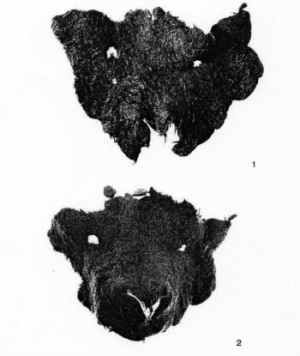

As opposed to the πρόσωπον and/or the persona, the mask, on the other hand, was a word, which derived from Proto-Germanic, *maskwǭ, meaning knot, mesh or netting. In its derived use we find it as Old English “mæscre”, meaning spot or blemish and in Old French, “Mascurer” – to blacken one’s face; hence its derived meaning as a nightmare or ghost.
To what extent “masking” played a role in the shamanic performances of Germanic, Pre-Christian religious and societal practice and rituals may only be hinted at. Archaeological finds from Haithabu and the ubiquitous mask on Runic stones indicate that the use of masks was omnipresent in ritual contexts; as well as in poetry where the use of “kennings” as a literary figure of speech used to “mask” the meaning, was predominant.
In this connection, it seems reasonable to consider the possible dichotomy between how the blessed transfiguration of the Lord and the revealing of his white face– his prósōpon – may have spilt over and into the dark transfiguration of the shaman, Odin, posing as eagle, four-legged animal, fish, snake or transgender figures. This ritualised transformation might have been cooked-up in the cauldron of Christianity meeting Heathendom.
Such a structured field of meaning would hold together on the one hand “persons” revealing their innermost and eternal qualities, while on the other hand “masks” would be imagined to cover up the boiling and liquid nightmares of monsters and ferocious wild animals. At the centre of this fight was (and is) the opportunity for either defeat or victory in a hostile environment.
With masks, we may conclude that time and the apocalypse entered the social field, constructed between the Greek prósōpon, the Latin persona, and the Germanic maskwǭ
Medical Masks – or the scientific approach
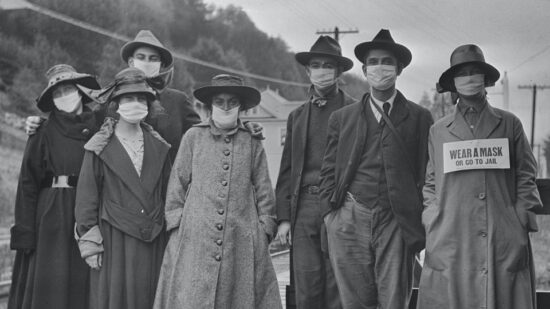
In the 17th and 18th century, doctors came to believe that epidemic diseases spread as decaying organic matter floating through the air as miasma. To what extent, this lead to the creation and use of medical masks is disputed. Perhaps, a clue may be had from the fact that the pompous doctor – sometimes known as the Dottore Spaccastrummolo (“Dr Hack-and-Bandage”) – became a stock character in the Commedia dell’ Arte, to be feared and disliked in equal measure.
Later, the identification of germs as potential carriers of diseases led to the gradual use of medical masks. First, the first use of medical masks took place in 1897, when the French surgeon, Berger, wore a face mask during an operation. Berger was familiar with the work of German bacteriologist Carl Flügge, who discovered that saliva contained bacteria. However, it was not until 1910, when the Chinese doctor, Wu Lien The, during the plague pandemic in Manchuria demanded his personnel at the hospital in Harbin to wear masks. Later, his work inspired doctors and other public personnel wearing masks during the Spanish Flu epidemic. Perhaps this led to a heroisation of Wu Lien The, and the more widespread Asian use of medicinal masks than traditional in a Western context?
The stories of these masks are told as “war-histories”, where the good behaviour is ultimately victorious through societal micromanagement. In a modern covid-19 context, this may be discerned in the endless advice on which types of masks should be used where, when and in what way (non-reuse, triple layer of fabric, best practice handling the medicianal masks etc).
Today, most public authorities during the covid-19 pandemic recommend mandatory covering up, making a medicinal mask (whether home-made or not) the utmost symbol of people engaged in respectable civic performances of altruism, solidarity and belief in “science”. Just as the wearing of Roman “personae” or “images” would help to enact the critical social construct of the order of the Roman Empire and the family, the mask in its 21st-century context is framed as an essentially “good” artefact; widely respected through its alledged contribution to civic development.
While the Greek prósōpon and the Latin persona function as theatrical props on a timeless scene, the Germanic maskwǭ and the medical mask play out their role in time, in a historical setting with a beginning, a middle and – perhaps – an apocalyptic end. A significant part of this social dynamic centres on shame, hence the nightmares featuring fearful social interactions between oneself as unmasked and the righteous masked crowd busy attacking the restless sleeper.
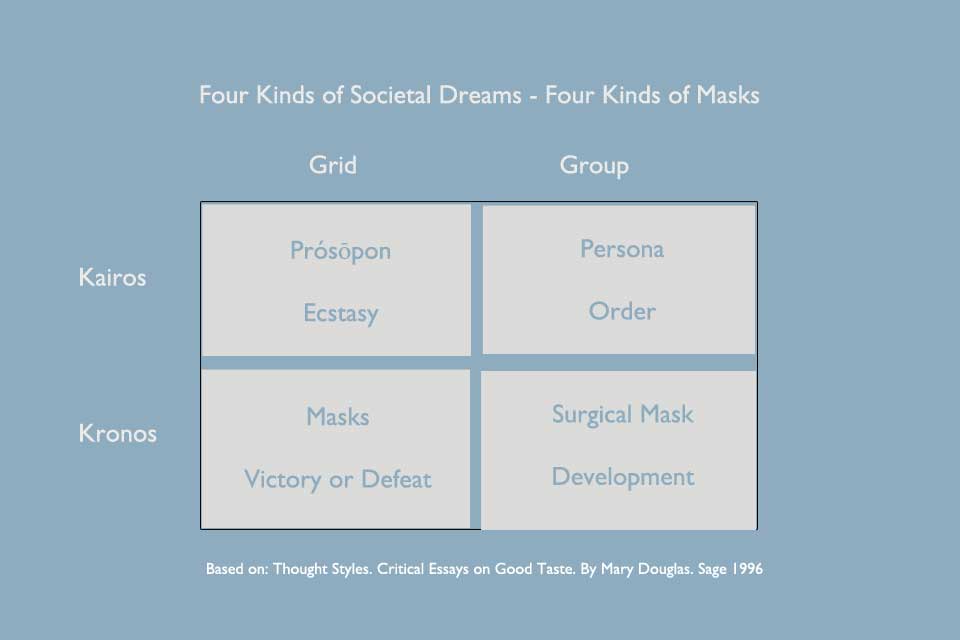
Stigmatisation and Rebellion

Recent meta-studies of wearing masks seem to affirm that the spread from contagious individuals can be halted significantly by their use of masks. Unfortunately, it is still debatable whether medical masks protect the healthy wearer from catching the illness, released by their sick contacts. History of tuberculosis shows, however, that limiting mask-wearing to sick people, have the potential to incur stigmatisation, whereby medical masks become means to “hide” the evil and putrid” aerosols spreading death and disease, rather than facilitating devices furthering the common good.
From this perspective, the medical mask stops being surgical and is instead turned into a traditional “mask” in the Germanic and medieval sense; where masks are seen as releasing all sorts of putrid and sulphuric beasts and monsters. From this perspective, we see significant parts of society become engaged in redefining medical masks, not as revealing goodness and togetherness, but as evil instruments used to transgress the private lives of “the others”, defining them as people and not just citizens.
The recent divergent performances of Biden and Trump’s presidential campaigns were exemplary in their use of the symbol of the medical mask. Who does not remember Donald Trump posing on the balcony of the White House, ripping off his mask in a defiant gesture?
Conclusion
We don’t precisely know how people experience having covid-19 related nightmares. At least no in-depth qualitative studies have so far been published.
However, it does seem that the nocturnal conflicts play out in the lower dichotomous field composed of on one hand the idea of a controlled developmental and scientific world aiming for a safe transition into the future, where people walk about as ideal-type righteous persons flaunting the ultimate symbol, their medical masks invoking the return to the bygone world of abundant wealth, pleasures and security; and on the other hand, the negation, which is the apocalyptic rebellion symbolised by nocturnal beasts fitted out with medieval-like masks, wreaking havoc in a world masking – what the insurrectionists – consider the reality and truth of the rampant depression, hunger, and job-loss by the “scientific necessity” to mask-up.
In its most abject and frightening form, this materialises as a full-blown medieval nightmare experienced by frightened people, feeling stigmatised by the – non-sick – persons, who as fundamentally righteous claim to avoid the plague by wearing medical masks.
Scientific postscript
When Covid-19 hit Denmark in March, a group of scientists and statisticians got together to set up a research programme. The aim was to decide the value of the protection, which masks might provide. A total of 3030 participants were randomly assigned to wear masks outside their home and for a month, while 2994 were assigned to a control; 4862 completed the study. Naturally, it took some time to calculate and write up the results. However, the international research community soon began to comment upon the research project and its set-up. Notably, some American research groups sought to disparage the results before publication. Rumour had it, mask-wearing had had no significant effect, causing worry among certain competing researchers in California. These caveats came to be reflected in the editorials accompanying the study when it was finally published. As of today, the jury is still out on the practical contribution of masking by healthy people. However, as the chief investigator, Henning Bundgaard has noted: it is no longer possible to redo the study, as masking is now globally widespread. It would also be unethical, given the results from in-vitro studies of aerosol-spreading in laboratories.
The background behind this controversy revealed the cultural cleavage between on the one hand medical mask-wearing advocates in the USA, who were fronted by globalists (and Chinese scientists) pointing to the well-known practice in the Far East; and on the other hand, populists and Trump-followers regarding Covid-19 as a hoax and a conspiracy; a position, which was univocally supported by Trump, who came to use the mask as a political symbol in the presidential election, thus playing into the hands of the fear-mongering rebels, who ended up spreading the virus inside the Capitol.
To mask or not to mask – that is the question? Meanwhile, the nightly medieval demons attack their hapless victims.
SOURCES:
Dreaming and the COVID-19 Pandemic: A Survey in a U.S. Sample
By Michael Schredl and Kelly Bulkeley
In: Dreaming, Vol. 30 (2020), No. 3, pp. 189-199
Pandemic Dreaming: The Effect of Covid-19 on Dream Imagery, a Pilot Study.
By Cassida MacKay and Teresa L. DeCicco.
In: Dreaming, Vol. 30 (2020), No. 3, pp. 222-235
Pandemic Dreams: Network Analysis of Dream Content During the COVID-19 Lockdown
By Anu-Katriina Pesonen, Jari Lipsanen, Risto Halonen, Marko Elovainio, Nils Sandman, Juha-Matti Mäkelä, Minea Antila, Deni Béchard, Hanna M. Ollila, and Liisa Kuula
In Frontiers in Psychology, 01.10.2020
Face Masks: Their History and the Values They Communicate
By John David Ike, Henry Bayerle , Robert A. Logan & Ruth M. Parker
In: Journal of Health Communication 12.01.2021
Effectiveness of Adding a Mask Recommendation to Other Public Health Measures to Prevent SARS-CoV-2 Infection in Danish Mask Wearers
A Randomized Controlled Trial
By Henning Bundgaard, DMSc, Johan Skov Bundgaard, BSc, Daniel Emil Tadeusz Raaschou-Pedersen, BSc, Christian von Buchwald, DMSc, Tobias Todsen, MD, Jakob Boesgaard Norsk, MD, Mia M. Pries-Heje, MD, Christoffer Rasmus Vissing, MD, Pernille B. Nielsen, MD, Ulrik C. Winsløw, MD, Kamille Fogh, MD, Rasmus Hasselbalch, MD, Jonas H. Kristensen, MD, Anna Ringgaard, PhD, Mikkel Porsborg Andersen, PhD, Nicole Bakkegård Goecke, PhD, Ramona Trebbien, PhD, Kerstin Skovgaard, PhD, Thomas Benfield, DMSc, Henrik Ullum, PhD, Christian Torp-Pedersen, DMSc, Kasper Iversen, DMSc
In: Annals of Internal Medicine, 18.11.2020
An evidence review of face masks against COVID-19
By Jeremy Howard, Austin Huang, Zhiyuan Li, Zeynep Tufekci, Vladimir Zdimal, Helene-Mari van der Westhuizen, Arne von Delft, Amy Price, Lex Fridman, Lei-Han Tang, Viola Tang, Gregory L. Watson, Christina E. Bax, Reshama Shaikh, Frederik Questier, Danny Hernandez, Larry F. Chu, View ORCID ProfileChristina M. Ramirez, and Anne W. Rimoin
PNAS Vol 118 (4) (January 2021)
